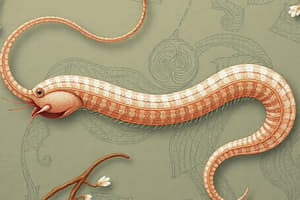Podcast
Questions and Answers
What is the primary function of the tegument in cestodes?
What is the primary function of the tegument in cestodes?
- To aid in reproduction
- To facilitate movement
- To absorb nutrients directly (correct)
- To regulate body temperature
What is characteristic of the nervous system of cestodes?
What is characteristic of the nervous system of cestodes?
- It has a complex brain structure
- It has a cerebral ganglion in the scolex (correct)
- It is decentralized with no central nerve center
- It is highly developed for sensory perception
What is unique about the reproductive system of true tapeworms?
What is unique about the reproductive system of true tapeworms?
- They are dioecious, with separate sexes
- They have a complex reproductive cycle
- They have a single reproductive system
- They are hermaphrodites, with both male and female reproductive systems (correct)
What type of excretory system do cestodes have?
What type of excretory system do cestodes have?
What is the function of microvilli in the excretory ducts of cestodes?
What is the function of microvilli in the excretory ducts of cestodes?
What is characteristic of operated eggs of cestodes?
What is characteristic of operated eggs of cestodes?
What is a characteristic of microtriches?
What is a characteristic of microtriches?
What is the common external opening for both male and female reproductive systems in cestodes?
What is the common external opening for both male and female reproductive systems in cestodes?
What is the mode of infection of Diphyllobothrium latum?
What is the mode of infection of Diphyllobothrium latum?
What is the clinical feature of heavy Diphyllobothrium latum infection?
What is the clinical feature of heavy Diphyllobothrium latum infection?
What is the shape of the egg of Diphyllobothrium latum?
What is the shape of the egg of Diphyllobothrium latum?
What is the characteristic feature of the scolex of Spirometra mansoni?
What is the characteristic feature of the scolex of Spirometra mansoni?
What is the size of the egg of Spirometra mansoni?
What is the size of the egg of Spirometra mansoni?
What is the second intermediate host of Spirometra mansoni?
What is the second intermediate host of Spirometra mansoni?
What is the mode of infection of Spirometra mansoni?
What is the mode of infection of Spirometra mansoni?
What is the infective stage of Spirometra mansoni?
What is the infective stage of Spirometra mansoni?
What is a characteristic feature of the scolex of Cysticercus?
What is a characteristic feature of the scolex of Cysticercus?
What is the characteristic of the eggs of Cysticercus?
What is the characteristic of the eggs of Cysticercus?
How many intermediate hosts are involved in the larval development of Cysticercus?
How many intermediate hosts are involved in the larval development of Cysticercus?
What is the characteristic of the vitelline glands of Cyclophyllidea?
What is the characteristic of the vitelline glands of Cyclophyllidea?
What is the characteristic of the genital pore of Pseudophyllidea?
What is the characteristic of the genital pore of Pseudophyllidea?
What is the characteristic of the oncosphere of Cyclophyllidea?
What is the characteristic of the oncosphere of Cyclophyllidea?
Which of the following is NOT a species belonging to the Order Cyclophyllidea?
Which of the following is NOT a species belonging to the Order Cyclophyllidea?
What is the common name of the parasite Diphyllobothrium latum?
What is the common name of the parasite Diphyllobothrium latum?
What is the characteristic of the scolex of Diphyllobothrium latum?
What is the characteristic of the scolex of Diphyllobothrium latum?
What is the size of the adult Diphyllobothrium latum?
What is the size of the adult Diphyllobothrium latum?
What is the intermediate host of Diphyllobothrium latum?
What is the intermediate host of Diphyllobothrium latum?
What is the definitive host of Diphyllobothrium latum?
What is the definitive host of Diphyllobothrium latum?
Where is Diphyllobothrium latum commonly found?
Where is Diphyllobothrium latum commonly found?
What is the color of the adult Diphyllobothrium latum?
What is the color of the adult Diphyllobothrium latum?
What is the primary way to avoid sparganosis?
What is the primary way to avoid sparganosis?
What is the most common localization of sparganum in human?
What is the most common localization of sparganum in human?
What is the clinical manifestation of cerebral sparganosis?
What is the clinical manifestation of cerebral sparganosis?
What is the treatment for sparganosis?
What is the treatment for sparganosis?
What is the primary method of diagnosis for sparganosis?
What is the primary method of diagnosis for sparganosis?
What is the common practice in Vietnam, Thailand, and parts of China that is responsible for ocular sparganosis?
What is the common practice in Vietnam, Thailand, and parts of China that is responsible for ocular sparganosis?
What is the type of sparganosis characterized by nodules in the oral mucosa?
What is the type of sparganosis characterized by nodules in the oral mucosa?
What is the type of sparganosis characterized by seizures, headache, and focal neurological signs?
What is the type of sparganosis characterized by seizures, headache, and focal neurological signs?
Flashcards are hidden until you start studying
Study Notes
Cestodes (Tapeworms)
- Lack a digestive system and absorb nutrients through their tegument.
- No digestive tract; absorb all nutrients directly through the tegument.
Tegument
- Syncitium: cytons connected by trabeculae (cytoplasmic bridges) to distal cytoplasm.
- Microtriches (singular microtrix): highly specialized microvilli covering the entire surface of the tegument of cestodes.
Nervous and Sensory System
- Main nerve centre: cerebral ganglion in the scolex.
- Motor and sensory innervation depends on the number and complexity of the scolex.
- Smaller nerves emanate from the commissures to supply the general body muscular and sensory endings.
Reproduction
- True tapeworms are exclusively hermaphrodites (Dioecious): have both male and female reproductive systems in their bodies.
- Reproductive system includes one or many testes, cirrus, vas deferens, and seminal vesicle as male organs, and a single lobed or unlobed ovary with the connecting oviduct and uterus as female organs.
Excretion and Osmoregulation
- Cestodes have the protonephridial flame bulb system typical of flatworms.
- Flame cell protonephridium embedded throughout the parenchyma.
- Excretory ducts are lined with microvilli involved in transport of excretory wastes and may help to regulate ionic concentrations of the excretory fluid.
Developmental Stages of Cestodes
- Egg: two types - Operculated and Non-operculated.
- Larvae: two types - Solid (e.g., Procercoid, Plerocercoid) and Cystic (true bladder) with single scolex (e.g., Cysticercus) or many scolexes and/or daughter cysts (e.g., Hydatid cyst, Coenurus cyst).
Order Cyclophyllidea Characteristics
- Large or small worms consisting of chains of segments.
- Scolex is quadrate with four cup-like round suckers.
- An apical rostellum with hooklets may be present.
- Vitelline glands concentrated in a single mass.
- Common genital pore is marginal (on lateral side of segment).
- No uterine opening for the exit of eggs from the gravid uterus.
- Eggs only escape from the rupture or disintegration of ripe segments.
Order Pseudophyllidea Characteristics
- Large worms consisting of a long chain of segments.
- Scolex has two slit-like sucking grooves (bothria) instead of suckers.
- Vitelline glands are widely scattered in the parenchyma and composed of many acini.
- Genital pores are on the ventral surface of the segment and are not marginal.
- Uterus opens to the exterior through which eggs come out.
- Eggs are operculated and can develop only in water; immature when oviposited (unembryonated) and oncosphere gives rise to ciliated embryo.
Classification
- Order Cyclophyllidea: less medically important, includes Taenia saginata, Taenia solium, Hymenolepis spp., Echinococcus granulosus, and Echinococcus multilocularis.
- Order Pseudophyllidea: includes Diphyllobothrium latum and Spirometra spp.
Life Cycle of Cestodes
- Adult in definitive host.
- Egg: operculated or non-operculated.
- Coracidium: ciliated embryo stage.
- Oncosphere: immature embryo stage.
- Solid larval form: procercoid larva.
- Cystic larval form: plerocercoid larva, cysticercus, coenurus, hydatid cyst, etc.
Diphyllobothrium latum
- Common name: Fish tapeworm.
- Order Pseudophyllidea.
- Adult: the largest tapeworm, up to 10m or more in length, grayish-yellow in color.
- Scolex is elongated, spoon-shaped, with longitudinal slits (bothria) and no rostellum and hooklets.
- Habitat: small intestine.
- Hosts: definitive host - human; reserve host - fish-eating animals; primary intermediate host - Cyclops or diatoms; secondary intermediate host - freshwater fish.
- Mode of infection: ingestion of improperly cooked or smoked fish infected with plerocercoid larvae.
- Clinical features and pathology: abdominal discomfort, loss of weight, loss of appetite, and some malnutrition; anemia and neurological problems associated with vitamin B12 deficiency in heavily infected individuals.
Spirometra mansoni
- Order Pseudophyllidea.
- Morphology: adult worm measures 60-100 cm in length; scolex is elongated and spoon-shaped with two sucking grooves.
- Egg: 52-78 µm × 31-44 µm, light yellow in color, operculated.
- Plerocercoid/Sparganum: tape-like, unsegmented body, white in color, infective stage.
- Definitive host: dog, cat, etc.
- 1st intermediate host: freshwater copepod.
- 2nd intermediate host: frog.
- Transport (paratenic/transfer) host: snake, bird, mammal.
- Mode of infection: drinking contaminated water, eating raw or undercooked meat of infected animals, or through larval transfer (applying flesh as a poultice on the eye or wound).
- Pathogenesis and clinical features: sparganosis in humans is a tissue infection caused by plerocercoid; can cause ocular, subcutaneous, oral, and cerebral sparganosis.
Studying That Suits You
Use AI to generate personalized quizzes and flashcards to suit your learning preferences.




